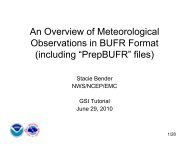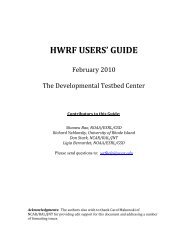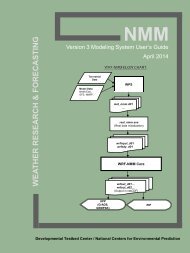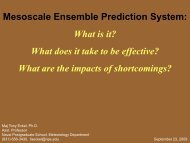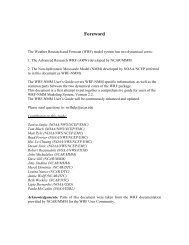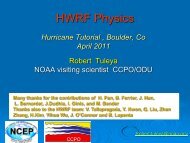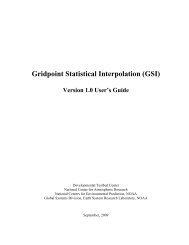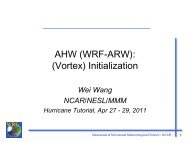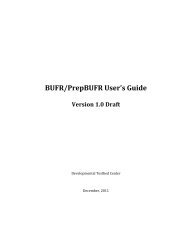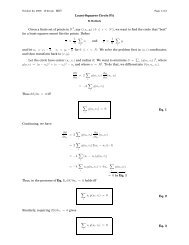WRF - Developmental Testbed Center
WRF - Developmental Testbed Center
WRF - Developmental Testbed Center
- No tags were found...
Create successful ePaper yourself
Turn your PDF publications into a flip-book with our unique Google optimized e-Paper software.
files to RIP-format data files. The primary difference between these two types of files isthat model output is in NetCDF or GRIB format and may contain all times and allvariables in a single file (or a few files), whereas RIP data has each variable at each timein a separate file in binary format.RIPDP reads in a model output file (or files), and separates out each variable at eachtime. There are several basic variables that RIPDP expects to find, and these are writtenout to files with names that are chosen by RIPDP (such as uuu, vvv, prs, etc.). These arethe variable names that RIP users are familiar with. However, RIPDP can also processunexpected variables that it encounters in model output data files, creating RIP data filenames for these variables from the variable name that is stored in the model output filemetadata.When you run make, it should produce executable programs called ripdp_mm5,ripdp_wrfarw, and ripdp_wrfnmm. Although these are three separate programs, theyserve the same purpose, and only ripdp_wrfnmm will be described here.The <strong>WRF</strong>-NMM model uses a rotated latitude/longitude projection on the E-grid, both ofwhich introduce special challenges for processing and plotting <strong>WRF</strong>-NMM data. RIPDPand RIP have been modified to handle the rotated latitude/longitude projection, however,the grid staggering in <strong>WRF</strong>-NMM requires additional data processing.Because of its developmental history with the MM5 model, RIP is inextricably linkedwith an assumed B-grid staggering system. Therefore, the easiest way to deal with E-griddata is to make it look like B-grid data. This can be done in two ways, either of which theuser can choose.E-gridB-gridH V H V h h hv vV H V H h h hv vH V H V h h hv vV H V H h h hIn the first method (iinterp=0), we define a B-grid in which its mass (h) points collocatewith all the mass (H) and velocity (V) points in the E-grid, and the B-grid's velocity (v)points are staggered in the usual B-grid way (see illustration below). The RIPDP-createddata files retain only the E-grid data, but then when they are ingested into RIP, the E-gridH-point data are transferred directly to overlapping B-grid mass points, and nonoverlappingB-grid mass points and all velocity points are interpolated from the E-grid'sH and V points. This is the best way to retain as much of the exact original data aspossible, but effectively doubles the number of horizontal grid points in RIP, which canbe undesirable.<strong>WRF</strong>-NMM V3: User’s Guide 7-25



